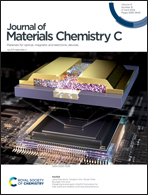Non-equivalent Mn4+ doping in mixed-anion host of K3Na(MoO2F4)2·H2O achieving short fluorescence lifetime and intense zero phonon line†
Abstract
The parity-selection rule for the Mn4+ d → d intra-configurational transition, if relaxed, would generate a Mn4+-doped red-emitting phosphor with short fluorescence lifetime, a desired feature when a phosphor is used in a white light-emitting diodes (WLED) lamp applied as a backlight in displays. We designed a non-equivalent substitution of Mn4+ for Mo6+ coordinated with F−/O2− mixed-anions, and obtained a K3Na(MoO2F4)2·H2O:Mn4+ red phosphor which exhibits fast decay (luminescence lifetime of ∼2 ms) and intense zero phonon line (ZPL) emission at 623 nm (ZPL/ν6 intensity ratio of 65.7% at 300 K) under 470 nm excitation. The local octahedron distortion which accounts for the luminescence features was discussed, and the crystal field strength and nephelauxetic effect were compared with analogues. The increasing trend of the ZPL/ν6 intensity ratio from 300 K to 80 K was explained, and the luminescence decay of the phosphors with a series of Mn4+ doping concentrations was studied. The K3Na(MoO2F4)2·H2O:3%Mn4+, when encapsulated with a garnet green phosphor on a blue LED, produced a WLED backlight with a wide color gamut above 103.5% of the NTSC standard.



 Please wait while we load your content...
Please wait while we load your content...